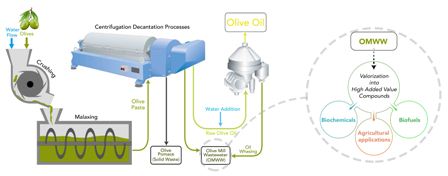Document Type : Review Paper
Authors
1
Instituto de Tecnología Agroindustrial del Noroeste Argentino (ITANOA), Consejo Nacional de Investigaciones Científicas y Técnicas (CONICET), Estación Experimental Agroindustrial Obispo Colombres (EEAOC), Av. William Cross 3150 (T4101XAC), Las Talitas, Tucumán, Argentina.
2
Planta Piloto de Procesos Industriales Microbiológicos (PROIMI-CONICET), Av. Belgrano y Caseros (T4000INI), S M de Tucumán, Tucumán, Argentina.
3
Facultad de Ciencias Exactas y Naturales, Universidad Nacional de Catamarca. Avenida Belgrano 300 (4700), SFV de Catamarca, Catamarca, Argentina.
4
Microbiología Superior, Facultad de Bioquímica, Química y Farmacia, Universidad Nacional de Tucumán, Ayacucho 471 (T4000INI), S M de Tucumán, Tucumán, Argentina.
Abstract
Countries producing olive oil generate a considerable amount of olive mill wastewater (OMWW), one of the most harmful agro-industrial effluents with a powerful polluting capacity. In fact, owing to its high pollution load, this effluent is extremely toxic to the whole soil-air-water ecosystem as well as to the living organisms inhabiting it (i.e., plants, animals, aquatic organisms, microorganisms, etc.). Currently, OMWW is discarded but since it includes carbohydrates, organic acids and mineral nutrients, as well as elevated contents of phenolics and other natural antioxidants compounds, it could be considered as a potential source of high value-added natural products. Therefore, the valorization of different waste streams including OMWW into fine biochemicals and the recovery of valuable metabolites via biotechnological processes is probably the main challenge faced by the olive oil industry. In light of that, the aim of the present review article is to summarize the state-of-the-art in relation to the exploitation possibilities and the use of OMWW to generate added-value compounds of great significance for the biofuel, pharmaceutical, cosmetic, chemical, food, and agriculture industries. Valorization of this significant waste steam in particular through a biorefinery platform could substantially enhance the environmental sustainability aspects of the whole industry while simultaneously contributing to the improvement of its economic viability.
Graphical Abstract

Highlights
- Olive mill wastewater (OMWW) can be exploited as feedstock for production of high value-added commodities.
- An overview on potential uses of OMWW and related valorization strategies is presented.
- A multifaceted approach integrating sustainable management and biorefinery concept is needed.
- Valorization of various waste streams including OMWW is the main challenge faced by olive oil industry.
Keywords

